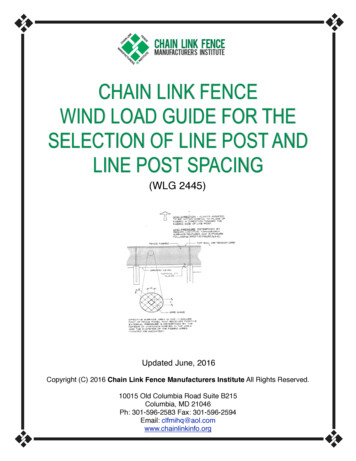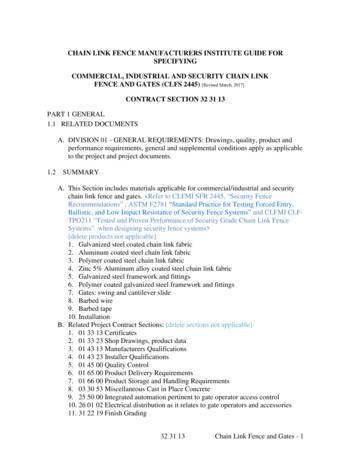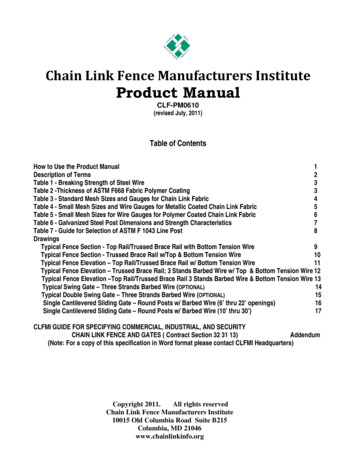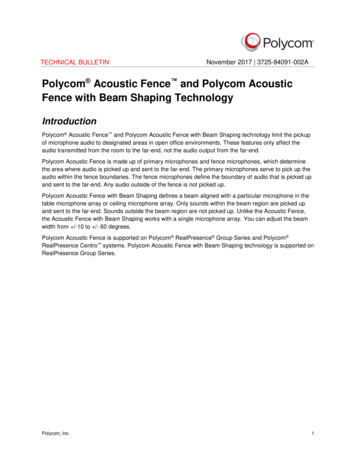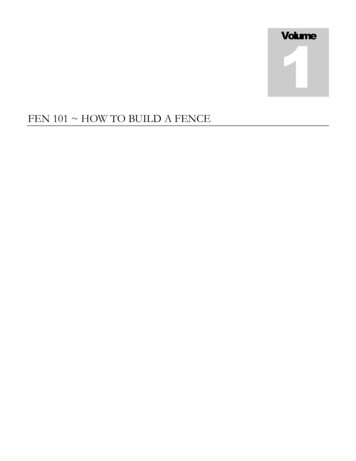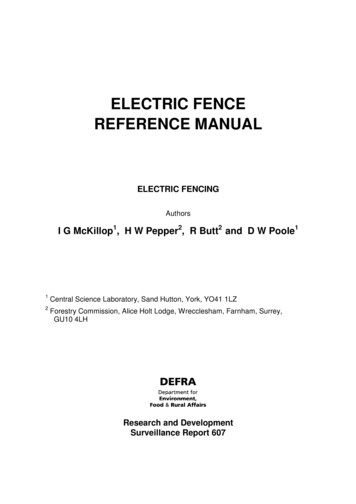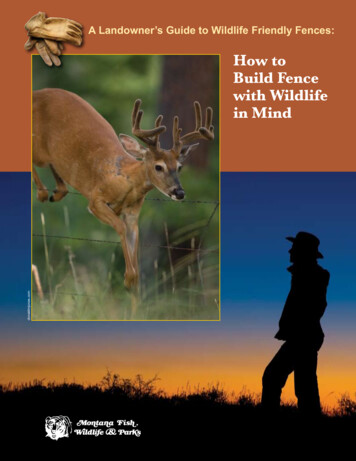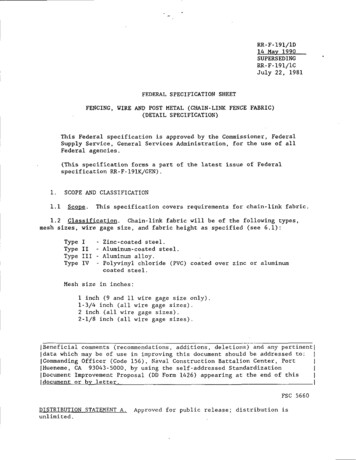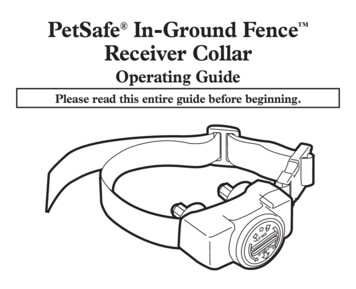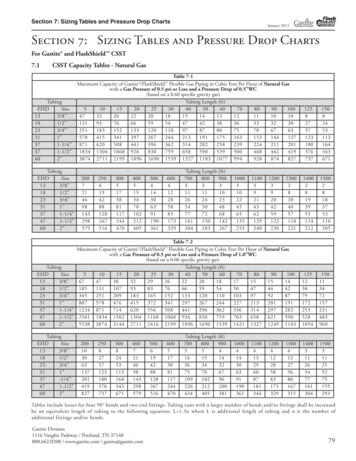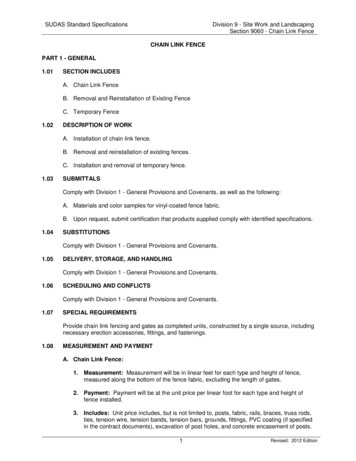
Transcription
SUDAS Standard SpecificationsDivision 9 - Site Work and LandscapingSection 9060 - Chain Link FenceCHAIN LINK FENCEPART 1 - GENERAL1.01SECTION INCLUDESA. Chain Link FenceB. Removal and Reinstallation of Existing FenceC. Temporary Fence1.02DESCRIPTION OF WORKA. Installation of chain link fence.B. Removal and reinstallation of existing fences.C. Installation and removal of temporary fence.1.03SUBMITTALSComply with Division 1 - General Provisions and Covenants, as well as the following:A. Materials and color samples for vinyl-coated fence fabric.B. Upon request, submit certification that products supplied comply with identified specifications.1.04SUBSTITUTIONSComply with Division 1 - General Provisions and Covenants.1.05DELIVERY, STORAGE, AND HANDLINGComply with Division 1 - General Provisions and Covenants.1.06SCHEDULING AND CONFLICTSComply with Division 1 - General Provisions and Covenants.1.07SPECIAL REQUIREMENTSProvide chain link fencing and gates as completed units, constructed by a single source, includingnecessary erection accessories, fittings, and fastenings.1.08MEASUREMENT AND PAYMENTA. Chain Link Fence:1. Measurement: Measurement will be in linear feet for each type and height of fence,measured along the bottom of the fence fabric, excluding the length of gates.2. Payment: Payment will be at the unit price per linear foot for each type and height offence installed.3. Includes: Unit price includes, but is not limited to, posts, fabric, rails, braces, truss rods,ties, tension wire, tension bands, tension bars, grounds, fittings, PVC coating (if specifiedin the contract documents), excavation of post holes, and concrete encasement of posts.1Revised: 2012 Edition
SUDAS Standard Specifications1.08Division 9 - Site Work and LandscapingSection 9060 - Chain Link FenceMEASUREMENT AND PAYMENT (Continued)B. Gates:1. Measurement: Each type, height, and span of gate will be counted.2. Payment: Payment will be at the unit price for each type, height, and span of gate.3. Includes: Unit price includes, but is not limited to, gate rails, fabric, stretcher bars,braces, vertical stay, hinges, latches, keepers, drop bar lock, center gate stop, andbarbed wire (if specified in the contract documents).C. Barbed Wire:1.Measurement: Measurement will be in linear feet for the length of fence to which barbedwire is applied, measured along the top of fence.2.Payment: Payment will be at the unit price per linear foot of barbed wire.3.Includes: Unit price includes, but is not limited to, furnishing and installing all necessarystrands of barbed wire, anchors, and barbed wire supporting arms.D. Removal and Reinstallation of Existing Fence:1. Measurement: Measurement will be in linear feet for each type and size of fenceremoved and reinstalled, measured along the bottom of the fence fabric, including lengthof gates.2. Payment: Payment will be at the unit price per linear foot for each size and type of fenceremoved and reinstalled.3. Includes: Unit price includes, but is not limited to, removing vegetation; removing all fencefabric, appurtenances, posts, and gates; removal of concrete encasement from posts;storage of the removed fencing materials to prevent damage; reinstallation of the posts,gates, and fabric, including all appurtenances; and replacement of any fence parts that arenot able to be salvaged and reinstalled. Replace items damaged from Contractor’soperations with new materials, at no additional cost to the Contracting Authority.E. Removal of Fence:1.Measurement: Measurement will be in linear feet of fence removed, measured alongthe bottom of fence fabric, including length of gates.2.Payment: Payment will be at the unit price per linear foot of fence removed.3.Includes: Unit price includes, but is not limited to, off-site disposal of fence (includingposts, concrete encasement of posts, gates, grounds, and barbed wire) and placing andcompacting backfill material in post holes.F. Temporary Fence:1.Measurement: Measurement will be in linear feet for each type and height of temporaryfence, measured along the bottom of the fence fabric, excluding the length of gates.2.Payment: Payment will be at the unit price per linear foot for each type and height oftemporary fence.3.Includes: Unit price includes, but is not limited to, furnishing, installing, and removingposts, fabric, ties, and fittings.2Revised: 2012 Edition
SUDAS Standard SpecificationsDivision 9 - Site Work and LandscapingSection 9060 - Chain Link FencePART 2 - PRODUCTS2.01FABRICA. General: Provide fence fabric manufactured from wire meeting the requirements of ASTM A817. Use No. 9 gauge wire woven in a 2 inch mesh. Construct knuckled selvedge at the topand bottom of the fabric.B. Zinc-coated Fabric: Comply with ASTM A 392.1. Wire Coated Prior to Weaving: Use Type II, Class 5 zinc coating per ASTM A 817.2. Fabric Coated After Weaving: Use Class 2 coating per ASTM A 392.CAluminum-coated Fabric: Meet the requirements of ASTM A 491. Coat wire prior toweaving fabric per ASTM A 817, Type I coating.D. PVC-coated Fabric: Comply with ASTM F 668, Class 2b.1. Apply PVC coating to zinc or aluminum-coated wire prior to weaving fabric.2. PVC coating color as specified in the contract documents, complying with ASTM F 934.2.02POSTS, RAILS, AND BRACESA. Standard weight (Schedule 40) pipe complying with ASTM F 1083.1. Galvanize pipe inside and out.2. Unless otherwise specified in the contract documents, provide the following nominal sizesfor the respective uses:Post UseLine PostTerminal Post*Top/intermediate Rail BracesGate PostFence Height48” and under48” to 96”Greater than 96”(nominal diameter) (nominal diameter) (nominal diameter)2”2 1/2"3”2 1/2"3”4”1 1/4"1 1/4"1 1/4"Refer to contract documents and ASTM F 900*Includes corner, angle, end, and pull posts.B. Pipe meeting the requirements of ASTM F 1043, Group 1A (Type A coating) or Group 1C(Type B coating). Use nominal sizes specified in ASTM F 1043.C. When PVC-coated fence is specified in the contract documents, coat all posts, rails, andbraces with a PVC-coated finish according to ASTM F 1043.1. Zinc-coated post per ASTM F 1083 prior to application of PVC coating.2. Color as specified in the contract documents, complying with ASTM F 934.D. Ensure all posts, rails, and braces provided for a given section of fence have similar coatingsand shapes.E. Provide caps for all posts. Comply with ASTM F 626.3Revised: 2012 Edition
SUDAS Standard Specifications2.03Division 9 - Site Work and LandscapingSection 9060 - Chain Link FenceFITTINGSA. Comply with ASTM F 626.B. Provide attachments to connect braces to posts by fittings that will hold both post and bracerigidly.C. Provide 3/8 inch diameter round steel diagonal tension rods with an appropriate commercialmeans for tightening. Provide a locknut or other device to hold the tightening device in place.D. Provide a suitable sleeve or coupling device, recommended by the manufacturer, to connectsections of top rail and provide for expansion and contraction.E. Use stretcher (tension) bars of the size specified in ASTM F 626 with suitable bands forattaching fabric to corner, end, or gate posts.2.04TIE WIRE AND TENSION WIREA. Tie Wire: Provide tie wires for chain link fence that are the size and type the manufacturerrecommends, but no smaller than No. 9 diameter for post ties or No. 12 diameter for rail andbrace ties. Comply with ASTM F 626.B. Tension Wire: Comply with ASTM A 824, with Type I or Type II (Class 3) coating per ASTMA 817.2.05BARBED WIRE SUPPORTING ARMSA. Comply with ASTM F 626 for type of arm configuration specified in the contract documents,as listed below:1. Type I: Single slanted arm for three barbed wire strands.2. Type II: Single vertical arm for three barbed wire strands.3. Type III: V-shaped arm for six barbed wire strands.4. Type IV: A-shaped arm for five barbed wire strands.B. Anchor arms to line, end, corner, and pull posts2.06BARBED WIREComply with ASTM A 121, design number 12-4-5-14R, Type A or Type Z (Class 3) coating.2.07GATESA. Provide the type, height, and width of gates as specified in the contract documents.B. Comply with ASTM F 900.C. Provide coating on gate, gate posts, and fabric as required for adjacent fence.2.08CONCRETEProvide concrete materials complying with Section 6010.2.09ELECTRICAL GROUNDA. Ground Rod: 5/8 inch diameter, 8 foot long copper-clad rod.B. Ground Wire: No. 6 AWG bare copper wire.4Revised: 2015 Edition
SUDAS Standard SpecificationsDivision 9 - Site Work and LandscapingSection 9060 - Chain Link FencePART 3 - EXECUTION3.01CHAIN LINK FENCE INSTALLATIONA. General: Comply with ASTM F 567. Construct fence at the location and height specified inthe contract documents.B. Posts:1. Post Location:a. Place posts in the line of the fence with equal spacing not to exceed 10 feet oncenter.b. Set terminal (end, corner, and gate) posts at the beginning and end of eachcontinuous length of fence and at abrupt changes in vertical and horizontalalignments. Place pull posts so that no more than 300 linear feet of fence isconstructed with only line posts.2. Post Setting:a. Dig or drill post holes to the dimensions specified in the contract documents.b. Set posts in concrete. Ensure all posts are set plumb in a vertical position.c. Form top of concrete footing so it extends 1 inch above grade and is sloped to directwater away from the post. To prevent frost heave, ensure footing is a uniform size tofull depth without flare at the top of grade.d. Install posts no less than 24 hours prior to installation of fabric.e. Set terminal, corner, angle, pull, and gate posts with the required brace-postassembly as specified in the contract documents.C. Rails:1. Top Rail: Pass the top rail through the base of the line post caps to form a continuousbrace from end to end of each stretch of fence. Join rail sections with sleeve or couplingdevice to allow for expansion and contraction. Securely fasten the top rail to the terminalposts with pressed steel connectors.2. Intermediate Rail: Securely fasten the intermediate rail between all line posts andterminal posts with pressed steel fasteners. Intermediate rail is required only on fences 8feet tall and taller.D. Braces:1. Securely fasten braces to the post by means of malleable iron or pressed steelconnections; then truss from the line post back to the end, gate, or corner post.2. Tighten the diagonal tension rod (truss rod) to produce proper tension.E. Fabric:1. Install fabric on the outside of the posts from the area being fenced or on the roadwayside of the posts.2. Secure one end of the fabric by a stretcher bar inserted in the final link of the fabric. Pullfabric taut with bottom selvedge, 2 inches above grade, before making attachmentelsewhere.3. Tighten and secure each end of each run of chain link fabric by a stretcher bar inserted inthe final link of the fabric. Secure stretcher bar to the end post by tension bands equallyspaced no more than 15 inches apart.4. Attach fence fabric securely to the braces, top rail, tension wire, and all intermediateposts with wire ties or bands at intervals of no more than 12 inches.5Revised: 2012 Edition
SUDAS Standard Specifications3.01Division 9 - Site Work and LandscapingSection 9060 - Chain Link FenceCHAIN LINK FENCE INSTALLATION (Continued)F. Bottom Tension Wire:1. Install bottom tension wire on fence 5 feet high and taller.2. Stretch bottom tension wire taut from terminal post to terminal post and securely fasten toeach intermediate post within the bottom 6 inches of fabric.G. Barbed Wire (When Specified):1. Install 3 parallel wires on each barbed wire supporting arm on the outside of the areabeing secured, unless otherwise specified in the contract documents.2. Pull wires taut, without kinks or twists, for tension.H. Gates: Install gates as specified in the contract documents.I.Electrical Grounds:1. Install electrical grounds as specified in the contract documents at the following locations:a) Where a primary electrical transmission line (not a secondary feeder line forindividual service) passes over the fence. Also install the ground on the fence at adistance of 25 to 50 feet in each direction from the crossing.b) Where the fence is adjacent to and within 50 feet of a primary electrical transmissionline, install the ground at 500 foot maximum intervals.c) In at least one location on each applicable straight section of fence.2. Drive ground rod vertically until the top is 6 inches below the ground surface.3. Clamp ground wire to the rod and to the fence in such a manner that each element of thefence is grounded.3.02REMOVAL OF EXISTING FENCERemove all fences, including posts and footings, within work areas unless otherwise specified inthe contract documents. Remove fence to first line post beyond construction limits. Replaceitems damaged from Contractor’s operations with new materials, at no additional cost to theContracting Authority.3.03TEMPORARY FENCEA. Furnish and install chain link fence fabric, posts, ties, and other materials for the heightspecified in the contract documents.B. Install according to permanent fence installation specifications, with the following exceptions:1. Drive posts into the ground. Do not set posts in concrete except at corner or temporarygate posts.2. Top rail, tension wire, and bracing will not be required.C. Remove temporary fence and materials when no longer necessary. Place suitable backfillmaterial in post holes. Fence materials will remain the property of the Contractor andremoved from the site.END OF SECTION6Revised: 2012 Edition
This page was intentionally left blank
Place fence fabric on roadway side of post. For certain curves,stream crossings, or other locations, the Contractor has the optionTop Rail10'-0''PostSpacingVariableFenceFabricTop RailPull PostPost CapPull Post1Fabric width as specified in the contract documents.2For fence heights greater than 8 feet, the depth of the fencepost footing is 3 feet plus 3 inches for each 1 foot in hei
A. General: Comply with ASTM F 567. Construct fence at the location and height specified in the contract documents. B. Posts: 1. Post Location: a. Place posts in the line of the fence with equal spacing not to exceed 10 feet on center. b. Set terminal (end, corner, and gate) posts at the beginning and end of each continuous length of fence and at abrupt changes in vertical and horizontal .
